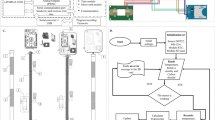Abstract
The objective of this study was to investigate the inaccuracy of a capacitance moisture sensor mounted on a combine harvester based on the datasets of six consecutive years. Variation of sensed volume is a major cause of measurement error for a capacitive sensor. The percentage of the sensed volume occupied by grain changes continuously by filling and emptying of the grain bin, which causes a large fluctuation in sensor output during on-the-go moisture sensing. At the beginning of the bin filling process when the grain bin is empty, under-measures were recorded and when it is approximately 60 % full, large over-measures are observed compared to the actual moisture values. This effect mainly influences the precision of the recorded site-specific moisture values and causes inaccurate yield maps. To assess the effect of varying sensed volume content during harvest operation, a bin level transmitter sensor was mounted on the top of the grain bin to continuously measure the height of the grain. A clear correlation between the actual amount of material (available space) in the grain bin to the bias from the standard moisture was demonstrated. The coefficient of determination was R2 = 0.86 for corn (Zea mays L.) and R2 = 0.87 for winter wheat (Triticum aestivum L.). By using equations generated from the datasets of consecutive years (2008, 2009 and 2010), an effective post-correction method for the recorded data is proposed.




Similar content being viewed by others
Abbreviations
- d :
-
Distance (m)
- U :
-
Voltage (mV)
- s:
-
Grain bin fill (%)
- C h :
-
Grain bin coefficient
- ξ nmin :
-
The highest difference from standard in negative range
- ξ nmax :
-
The highest difference from standard in positive range
References
Amoodeh, M. T., Khoshtaghaza, M. H., & Minaei, S. (2006). Acoustic on-line grain moisture meter. Computers and Electronics in Agriculture, 52, 71–78.
Arslan, S. (2008). A grain flow model to simulate grain yield sensor response. Sensors, 8, 952–962.
Arslan, S., & Colvin, S. T. (2002). Grain yield mapping: Yield sensing, yield reconstruction, and errors. Precision Agriculture, 3, 135–154.
ASAE Standards. (1998). ASAE S352.2 Moisture Measurement-Unground Grain and Seeds. St. Joseph, MI: American Society of Agricultural Engineers.
Birrell, S. J., Sudduth, K. A., & Borgelt, S. C. (1996). Comparison of yield sensors and techniques for crop yield mapping. Computers and Electronics in Agriculture, 14, 215–233.
Doerge, T. (1996). Weigh wagon vs. yield monitor comparison. Crop Insights, 7(17), 1–5.
Eubanks, J. C., & Birrell, S. J. (2001). Determining moisture content of hay and forages using multiple frequency parallel plate capacitors. Paper No. 011072. St Joseph, MI: ASAE.
Jukic, Z., Janusic, V., Matin, A., & Tomic, F. (2007). Water release rate from corn kernel affected by cropping intensity. Cereal Research Communication, 35, 569–572.
Kim, K. B., Lee, J. W., Lee, S. S., Noh, S. H., & Kim, M. S. (2003). On-line measurements of grain moisture content using RF impedance. Transaction of ASAE, 46(3), 861–867.
Kumhála, F., Prošek, V., & Blahovec, J. (2009). Capacitive throughput sensor for sugar beets and potatoes. Biosystems Engineering, 102, 36–43.
Kumhála, F., Prošek, V., & Kroulik, M. (2010). Capacitive sensor for chopped maize throughput measurement. Computers and Electronics in Agriculture, 70, 234–238.
Lawrence, K. C., Funk, D. B., & Windham, W. R. (2001). Dielectric moisture sensor for cereal grains and soybeans. Transaction of ASAE, 44(6), 1691–1696.
Loghavi, M., Ehsani, R., & Reeder, R. (2008). Development of a portable grain mass flow sensor test rig. Computers and Electronics in Agriculture, 61, 160–168.
Maertens, K., Reyniers, M., & De Baerdemaeker, J. (2004). Using a virtual combine harvester as an evaluation tool for yield mapping systems. Precision Agriculture, 5, 179–195.
Nelson, S. O. (2005). Dielectric properties measurement for agricultural applications. Paper No. 053134. St Joseph, MI: ASABE.
Neményi, M., Mesterházi, P. Á., Pecze, Zs, & Stépán, Zs. (2003). The role of GIS and GPS in precision farming. Computers and Electronics in Agriculture, 40(1–3), 45–55.
Pierce, F. J., Anderson, N. W., Colvin, T. S., Schueller, J. K., Humburg, D. S., & McLaughlin, N. B. (1997). Yield mapping. Site-Specific Management for Agricultural Systems (pp. 211–243). Madison, WI: ASA, CSSA, and SSSA.
Reyns, P., Missotten, B., Ramon, H., & De Baerdemaeker, J. (2002). A review of combine sensors for precision farming. Precision Agriculture, 3, 169–182.
Reyns, P., Spaepen, P., & De Baerdemaeker, J. (2000). Site-specific relationship between grain quality and yield. Precision Agriculture, 2, 231–246.
Sanaei, A., & Yule, I. J. (1996). Yield measurement reliability on combine harvesters. ASAE Paper No. 96-1020. St. Joseph, MI: ASAE.
Schueller, J. K. (1996). Impediments to spatially-variable field operations. Computers and Electronics in Agriculture, 14, 249–253.
Snell, H. G. J., Oberndorfer, C., Lücke, W., & Van den Weghe, H. F. A. (2002). Use of electromagnetic fields for the determination of the dry matter content of chopped maize. Biosystems Engineering, 82(3), 269–277.
Stafford, J. V., Ambler, B., Lark, R. M., & Catt, J. (1996). Mapping and interpreting the yield variation in cereal crops. Computers and Electronics in Agriculture, 14, 101–119.
Zhao, Ch., Huang, W., Chen, L., Meng, Z., Wang, Y., & Xu, F. (2010). A harvest area measurement system based on ultrasonic sensors and DGPS for yield map correction. Precision Agriculture, 11, 163–180.
Zoerb, G. C., Moore, G. A., & Burrow, R. P. (1993). Continuous measurement of grain moisture content during harvest. Transactions of the ASAE, 36, 5–9.
Acknowledgments
The research was financed in the framework of the TÁMOP-4.2.2. B-10/1-2010-0018 project entitled “Talentum-Improvements in the conditions available for encouraging talented students at the University of West Hungary” with funds from the European Union and the European Social Fund.
Author information
Authors and Affiliations
Corresponding author
Rights and permissions
About this article
Cite this article
Csiba, M., Kovács, A.J., Virág, I. et al. The most common errors of capacitance grain moisture sensors: effect of volume change during harvest. Precision Agric 14, 215–223 (2013). https://doi.org/10.1007/s11119-012-9289-y
Published:
Issue Date:
DOI: https://doi.org/10.1007/s11119-012-9289-y




